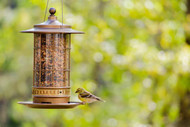Planning To Buy A Bird Feeder? These Are The Types You Should Know About
Posted by Todd on Aug 5th 2023
Several types of bird feeders can help offer a variety of food items and attract the greatest variety of birds in your backyard. A perfect bird feeder will be sturdy enough to withstand the vagaries of the winter weather and squirrels. It should be tight enough to keep seeds dry, easy to keep clean and assemble. Let us see the different types of bird feeders and how you can select the right one for your yard.
Platform Or Tray Feeders
These bird feeders can attract the widest variety of seed-eating birds, such as starlings, pigeons, house sparrows, native sparrows, and grosbeaks. Platform feeders offer no protection against snow and rain. Since they do not have excellent drainage, the seeds can get wet enough to sprout, thus fostering fungal and bacterial growth. These feeders also tend to collect bird droppings which can quickly soil the seed in the bird feeder.
Remember that the best tray feeders have a screened bottom to promote complete drainage. The base will also be removable for frequent housing. Make sure that you offer only enough seeds in the tray feeder so that they can be finished in a day or two. You can shake out the bottom every time you add new seeds. Platform feeders should be installed on an effective squirrel baffle on the pole of the suspension chain. These feeders can also act as an open invitation to chipmunks and squirrels.
Hopper Feeders
These types of bird feeders protect the seeds against weather and bird droppings. But if the seeds inside get wet, they can breed bacteria and fungi. Hopper feeders can attract most birds, like cardinals, jays, sparrows, finches, buntings, titmice, grosbeaks, and chickadees. However, with these creatures, they also attract squirrels. Most hopper feeders can hold enough seeds for several days. Although this is very convenient for you, it can be dangerous for the birds if the seeds inside can get wet. These feeders are also more difficult to clean than tray feeders.
Window feeders
These small plastic feeders can be attached to window glass with suction cups. Window feeders can attract chickadees, finches, titmice, and some sparrows. These feeders can give you a close-up view of the birds. Their placement also makes them the safest of all feeders. Since most birds feed while standing on the seeds in window feeders, the food is at risk of getting soiled. Hence the seeds in this feeder should be changed daily, and the feeders should be kept clean.
Tube Feeders
These bird feeders are hollow and thus keep the seeds fairly clean and dry. The ones that come with metal feeding ports are squirrel resistant. Tube feeders can attract small birds like grosbeaks, sparrows, titmice, finches, and chickadees, depending upon the size of the purges under the feeding ports. But larger species are also attracted to these feeders, such as jays and grackles. Tube feeders with perches above the feeding ports are designed for seed-eating birds that can feed upside down.
To Conclude
Nyjer and suet feeders are also available apart from the above bird feeders. When buying one, list your preferences about what type of designs you want, the variety of birds you want to attract, and how big of a bird feeder you want. This will help you make the right choice.
Featured Image Source: https://media.istockphoto.com/id/1223262266/photo/yellow-goldfinch-bird-at-the-bird-feeder-in-the-backyard.jpg?s=612x612&w=0&k=20&c=r8yFqLGuW8SA-S-YL1BGtWEtMf5HOIdVmaSd8KJjlhE=
